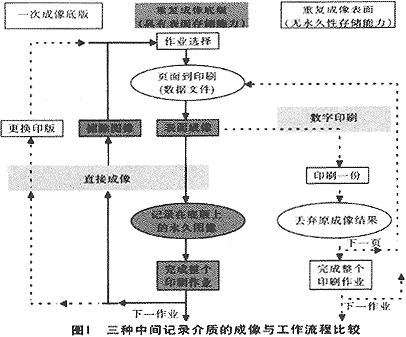1 Imaging Plate and Repeated Image Plate
The traditional PS plates are widely used in offset printing plates. Because of the low price and technical reasons, printing plates can only be used once. Both the computer-to-plate systems and the presses that use the direct platemaking process (for example, waterless offset presses in Heidelberg) require the use of directly imaged plates. From the perspective of imaging times, CTP plates can be divided into one imaging plate and multiple imaging (repeated imaging) plates. The so-called one-time image plate means that the image information recorded on the plate is permanent once the plate has been imaged; the multiple image plate can also record the permanent print image, but it can be erased and reappeared when needed. Imaging.
With the advent of direct imaging technology, people began to research and develop reproducible printing plates. This is not only because the technology has the ability to produce this type of printing plate, but the main reason is economic.
Any imaging method (including conventional offset printing) can be considered as a technique to modify the surface characteristics of a plate using a certain technology. The ultimate goal is to treat the surface of the plate as hydrophilic and ink-repellent areas with different properties. Therefore, whether or not the plate can be repeatedly imaged depends on whether the plate surface can be restored to its original state after being divided into two states. If it is possible, the plate is reproducible. Although from the physical and chemical properties of the material, there is the possibility that its surface properties can be restored to its original state after being changed, but a specific series of process and technology problems need to be solved when it is realized. The economic significance of the reproducible imaging plate is very obvious, not only can save the printing plate, but also can save the time to replace the printing plate.
From the perspective of recording information, digital printing systems based on electrophotographic imaging, ion imaging, and magnetic imaging also need to transfer digital textual information from computer to paper through an intermediate medium, but they differ from traditional offset printing and Plates used in computer-to-platemaking processes. Here, the intermediate media for transferring graphic and text information is divided into two major categories. The first type of intermediate media is called a printing plate. The term "Master" is used to distinguish it from an intermediate media such as a photoconductor drum used in a digital printing press; Intermediate media such as photoconductor drums used in digital presses are called imageable surfaces. Such surfaces do not have the ability to permanently store information, because every time a print is produced, it needs to be reimaged, and the original imaging content can Erase immediately. From the foregoing description, it can be seen that the bottom plate has the capability of permanently recording information, and can be further subdivided into two types: once imageable master and reimageable master, wherein one imaging master plate is not only Used in traditional printing processes, it is also used by most of today's direct platemaking systems.
2 Repeated Imaging vs. One Imaging Plate? Comparison of Imageable Surfaces

Figure 1 shows the relationship between the three types of replication technologies using a single imaging master (traditional printing process), reproducible imaging master (computer-to-printer plus direct image printing system), and imageable surface (digital printing system). It also describes How a repeatable imaging printing system and a digital printing system can handle the working procedures of multiple print jobs. The reproducible imaging master allows the printed image to be permanently retained. It can be reused within one print cycle without the need to reimage the next print. When a print job is completed, the original image recorded on the master must be erased and prepared for imaging the next print job. Erasing the original image means that the plate needs to be restored to its original state (this is called neutralization of the surface properties of the master) in order to image the next print job.
Figure 1 also shows the workflow of a Computer to Press/Direct Imaging (using one imaging master) printing system. The printing plate must be replaced after each printing job. In addition, Figure 1 also shows a comparison of the workflow of a direct-imprinting (ie, digital printing) system with a one-touch imaging master and a duplicated imaging master printing system. The digital printing system must be imaged again after completing each physical printing page, even if the same Pages must also do this, for example, digital printing based on electrophotography.
The printing system using the reimageable master is still in its infancy, the main advantage is that the material consumption can be reduced, and the production preparation time is shortened because there is no need to change the printing plate when transferring from one printing job to another, thereby simplifying the work. Process. At the same time, the same printing plate can be used during the entire printing task, which is advantageous for ensuring consistency of printing quality.
Digital printing is essentially a non-imaging printing technology such as electrophotographic imaging, ion imaging, magnetic imaging, and thermal imaging. For digital printing systems based on non-impact printing technology, although the imaging surface has the capability of reproducible imaging, each printed page must be re-imaged. Therefore, each printing page generated by digital printing has quality fluctuations. It is difficult to avoid, and this quality fluctuation can be perceived by the human eye. (to be continued)
Poe Umbrella,Transprant Umbrella,Rain Umbrella
Haixin Umbrella Industry Co., Ltd. , http://www.hzfoldumbrella.com